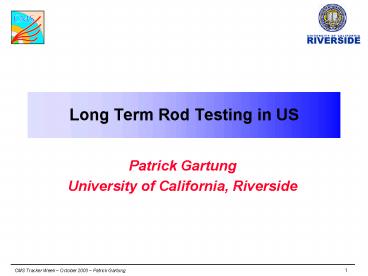Long Term Rod Testing in US - PowerPoint PPT Presentation
Title:
Long Term Rod Testing in US
Description:
Long Term Rod Testing in US Patrick Gartung University of California, Riverside – PowerPoint PPT presentation
Number of Views:83
Avg rating:3.0/5.0
Title: Long Term Rod Testing in US
1
Long Term Rod Testing in US
- Patrick Gartung
- University of California, Riverside
2
Rod Acceptance Testing
- No electrical test done yet
- To readout frames you need to attach/detach
hybrid - Following example of TEC
- Rod is powered and connected to FEC
- I2C commands sent to optohybird to vary gain and
bias - Laser output is checked on oscilloscope
- Rod is unpacked and visually inspected for damage
then placed in the assembly fixture
3
Module installation testing
- Rod is powered and connected to DAQ
- The rod is biased and noise and calibration
measurements are made to determine if any bonds
were broken (as indicated by low noise and
calibration response). - Modules with broken bonds are replaced and the
rod is retested. - For double sided rods test after inner 6 modules
are installed then install outer 6
- Modules are installed in the rod
4
Long Term Testing
- Rods are placed in test box, connected to the
chiller, powered and connected to DAQ - Rods are biased and thermal cycled for several
days - Periodic measurements are made with test software
to determine any failures - Chiller is controlled by independent interlock
system which can communicate with test software
on DAQ system.
5
Single Rod Test Stand
OEC (12 channels)
DAQ PC with 2 FED
CTRL adapter and cables
Cold box with dry air
chiller
High voltage (36 channels)
Low voltage
- Work done by Jim Lamb (UCSB student)
- Readout 1 SS or DS rod
- Prototype set up at UCSB
- Currently using XROD to take pedestals
- Will thermal cycle rod with chiller control
6
Multi-rod test stand status
- Prototype freezer moved from Rochester to
Fermilab October 11. - Second freezer will be shipped to UCSB early
December. - Designed and built an electronic circuit to
command the coolant, vacuum and compressed air
valves - Allows a low current signal to completely control
flow of coolant and the application of compressed
air and vacuum - Completed the automation of the procedure for
loading and unloading of rods - Work done by Ricardo Eusebi (Rochester student)
- Labview VI running on interlock PC will guide
user - User selects install rods and PC sets freezer
in proper condition - PC closes coolant valves and drains pipes
- User is prompted to install rods and click
continue - PC opens coolant valves and fills pipes
- After long term test user will select remove
rods and the reverse procedure will be followed.
7
Assembly diagnostic software
- Currently using XROD
- Quickly determine optohybrid gain and bias
settings, FED timing and PLL timing - Perform quick noise measurements to check for
opens
8
Long term test software
- Lt is being extended to test modules on
substructures - Working with Wim Beamont to define settings for
rods - Will beta test on rod in the next few weeks
- Chiller control system listens on TCP port for
set temperature commands from Lt - Ability to read and record temperatures and
currents for free - Scripting of temperature change, voltage change
and various tests for free
9
Equipment needs
- To complete two single rod test stands
- Need 1 TSC, 2 OEC (2nd OEC on motherboard)
- 2 OMUX crates with 4 mux cards each
- (Optional) 4 electrometers
- Short term for multi-rod test stands
- 2 TSC, 2 FED, 2 FEC
- 2 OMUX crates with 4 mux cards each
- 4 OEC on 2 motherboards
- 2 CERN low voltage power supplies































